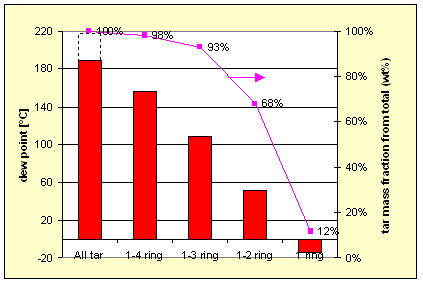Tar dew point
What is a tar dew point?
The tar dew point is the temperature at which the real total partial pressure of
tar equals the saturation pressure of tar. Once the actual process temperature
passes the thermodynamic tar dew point, tar can condense out. It does not mean
that condensation will always happen. Therefore kinetics might be slow. Then
the gas is called over-saturated.
Dew point model?
TNO.ECN developed a dew point model for the calculation of a tar dew point from a
measured tar composition. The model includes vapour/liquid equilibrium data for
the tar compounds in the producer gas from a downdraft or fluidized bed
gasifier. The calculation is based on ideal gas behaviour. Raoult’s law is
applied for the calculation of a mixture of hydrocarbons, using the vapour
pressure data of individual compounds.
Simple model
The TNO dew point model has been simplified. The simple model contains 6
important tar compounds. This simple model will not predict the tar dew point
very accurate but will give a better understanding on the magnitude of
dew points for tar compounds with 1-5 aromatic rings. The results of the simple
model can NOT be used for publication or process engineering.
Complete model
For accurate tar dew point calculations the Complete model is advised. The
Complete model includes the relevant characteristics of 34 individual tar
components. The model has been validated at atmospheric pressure with real
producer gas from our
laboratory scale fluidised bed gasifier (WOB). The model could predict
the tar dew point with an accuracy of ±2 °C in the temperature range of
100-175°C. In on going research the model will be validated in the temperature
range of 20-100°C.
Figure 1 is an example of a tar dew point calculation with the TNO’s complete tar dew point model from a real tar composition, measured with the SPA method in producer gas from the 1 kg/h bubbling fluidized bed (BFB) gasifier at TNO. The tar dew point is circa 190°C. Elimination of tar components with more than 4 aromatic rings, which corresponds with the removal of circa 2% of the total tar amount, decreases the dew point from 190°C to circa 150°C. The dew point decreases further to 100°C when the tar compounds with four aromatic rings are removed.

Figure 1: Relation between the tar dew point and the tar composition divided in size of compounds.
The results of the complete model can be used in publications with reference to the TNO Thersites site.

